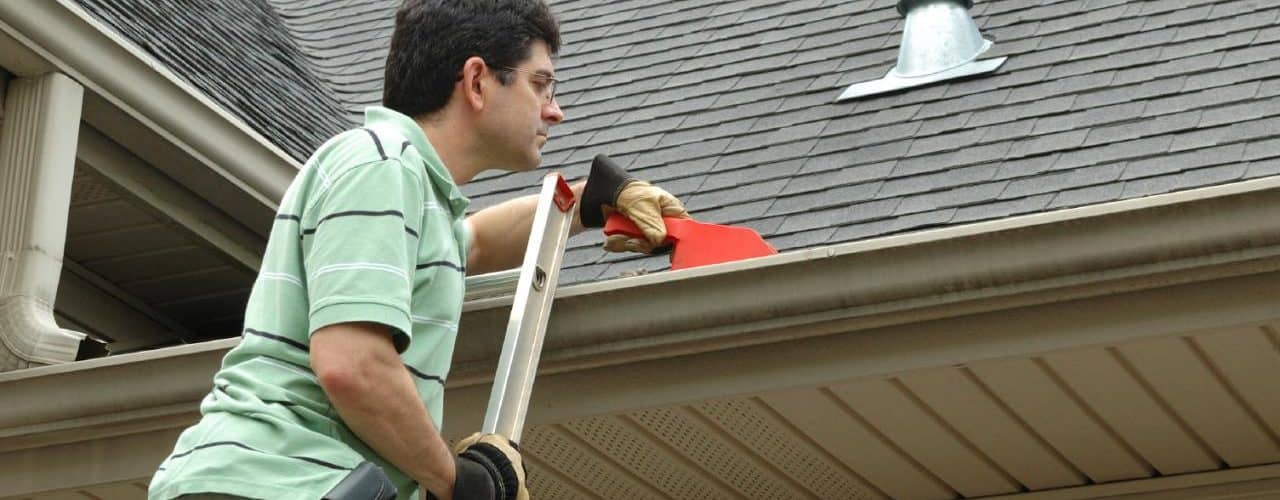Gutter cleaning is the single most important job when it comes to preventing basement flooding and protecting a home’s foundation from water damage. Installing gutters is little more than constructing a comprehensive channeling system. It diverts rainwater away from the home’s façade and foundation.
Maintained properly, it routes the water to a venue where it does not damage any structures. Whereas protection from rain damage is only as good as the gutter system a homeowner chooses to install, actual functionality of the system is only as effective as the rain gutter cleaning steps the homeowner takes. Assembling tools for the job is easy.
The homeowner needs:
- A tall ladder
- Sturdy household broom
- Curved gutter cleaning brush
- Garden hose
- Heavy duty work gloves
- Gutter guards (optional)
1. Window gutter cleaning begins with roof debris removal. Grab a ladder and household broom; climb up on the roof and clear away leaves and seed pods. Do this every few months to prevent buildup of leaves in the rain gutters, but even more often in fall if there are deciduous trees overhanging the roof.
2. Invest in a good quality roof gutter cleaning brush – eGutter sells them for as little as $14 – that features stiff bristles for removing even the dried on gunk inside the various trenches. Notice that the brush has a pronounced curvature, which makes it perfect for cleaning with brisk back and forth motions. Put on the work gloves – laboring around gutters may put the soft flesh of the hands in contact with bent or jagged metal edges – and start using the brush to remove debris and buildup from inside the rain gutters.
3. Flush the entire rain gutter system with the garden hose. This loosens any debris that might still be stuck inside a hollow pipe, where it may well be out of sight.
4. Inspect gutter guards and clean them as well. Drop-in guards rely on fine mesh that keeps leaves out of the rain gutters and spouts, but the mesh can easily clog if not consistently cleaned off. A hinged guard needs the occasional opening to let gravity take care of the debris. If semi solid covers protect the gutters, it is crucial to check them for hail damage and make sure that they are still in proper shape and working order.
5. If the rain gutters do not have any guards at all, installing a weather appropriate option is a necessary maintenance step to take after finishing the cleaning job. Remember that even gutter guards let small debris particles through and do not end the need for a thorough cleaning at least once or twice a year.
Following these steps is not a guarantee for a trouble-free rain gutter system, but it greatly decreases nasty surprises during heavy downpours. Of course, in spite of best intentions, home gutter cleaning just seems to get continuously bumped off the list of to-do items, and before long a clog develops. Now what?
1. Removing a clog starts with locating the blockage and gauging its extent. The most common culprit is the gutter system underneath deciduous trees or those that shed large seed pods, such as magnolias.
2. Dislodge the clog with a concentrated spray of water from the hose. It might need the alternate spraying and mechanical pushing with the help of the gutter brush to finally flush out the obstructive materials.
3. If all else fails – and it truly has been a considerable amount of time since the gutters and downspout were properly cleaned – it is necessary to dismantle the clogged section and attack the offending debris from both ends with the brush.
4. Protect the downspout in the future with gutter pumps – a pack of six retails for as little as $33 to $60 – that siphon water from the horizontal channels but keep debris out of the vertical tubes.
It is obvious that twice a year commercial gutter cleaning has the potential of not only protecting a home from basement flooding but will also go a long ways to prevent the buildup of organic matter clogs that result in labor-intensive removal.
<>



